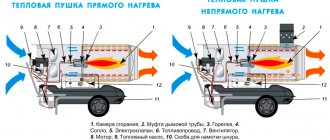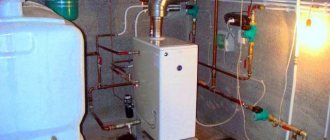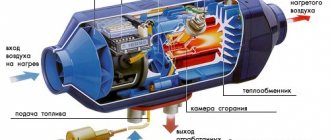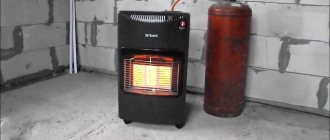With the onset of cold weather, people begin to think about how they can heat their home, cottage, garage, office and other premises. One solution is to purchase a diesel heater. In the modern world there are no problems with choice, because the market offers a large assortment of these devices, which differ in operating principle, manufacturer and cost. In this review, we will help you decide on the type and model of diesel heater.
The design of a diesel heater and its operating principle
The operating principle of a diesel heater is very similar to an electric one, but the difference is that the former runs on diesel fuel, while the latter requires electricity. The diesel fuel heaters package includes:
- The combustion chamber;
- Spark plug;
- Motor and fan impeller;
- Pump;
- Filters for air purification at the inlet and outlet;
- Fuel tank;
- Controller;
- Pipes through which air flows;
- Flame stabilizers;
- Fuel nozzle.
Diesel fuel is poured into the tank, from where it enters the combustion chamber.
Next, the fan will fan the air to ignite the fuel. Filters clean the air from various particles and combustion products of liquid fuel, and controllers regulate the air temperature. See also -
How to choose an inverter heater for home and street
Place of application of diesel heater
Heaters running on liquid diesel fuel can be used in different rooms. The place of application depends both on the dimensions of the device and on the size of the heated room. For example, small units, such as heat guns, are perfect for the garage.
Infrared diesel heaters will fit perfectly where it is necessary to heat the air in an open space: a cafe, a veranda. Note that this type of device is also suitable for indoor use.
Solar gas heaters can be taken with you, for example, on a hike, and you can cook food on it, and it is also perfect for heating a summer house. We will talk about all these types of devices a little later.
Types and principle of operation
All diesel units can be divided into two types: direct and indirect heating.
As for the first ones, they come in pump and ejection types. Among other things, there are also different options for igniting the fuel that are used in fuel heaters, but in fact, this does not have much impact on the characteristics of the device.
Diesel heaters can be used in rooms where a natural or forced ventilation system is implemented, as well as in open areas.
Special dimensional mobile heaters are intended for heating various production, industrial, warehouse or domestic premises. Very often, diesel heaters are used on construction sites, but can also be used in residential areas.
Types of diesel heaters
Heaters running on diesel fuel are divided into the following types:
- Stationary;
- Air;
- Infrared;
- Direct acting devices;
- Indirect acting units.
The differences between the last two are that direct heating heaters are not equipped with filters and air vents for combustion products. It must be remembered that when such a unit operates, the latter enter directly into the room in which it is located. Therefore, they are used in non-residential premises or for urgent repairs during cold weather.
Heaters of this type are characterized by a combustion control system. Note that it works in automatic mode. The large fuel tank allows for refueling every 10–15 hours.
Indirectly heated diesel heaters do not emit combustion products into the environment, which was achieved through the use of filters that purify the air.
These devices are perfect for residential premises. See also –
Are infrared heaters harmful to health or not?
Infrared diesel heater
This type of unit can be used to heat buildings with high ceilings, because they are usually installed on the ceiling or wall. Infrared radiation will help to heat even gazebos located outdoors.
Such heaters act similarly to solar radiation. When fuel is burned, heat rays are generated, aimed at heating objects, people or walls, which, in turn, already heat the air in the room with their heat. This helps save fuel consumption, which is undoubtedly an advantage. These devices are recommended for use in rooms that are characterized by poor thermal insulation or there are restrictions on the use of electricity or there is a shortage of it.
Air Diesel Heater
The operation of an air heater resembles the principle of operation of a fan. This unit is equipped with a durable housing that protects against overheating and mechanical damage. Heat guns, which are a type of air heater, heat a room through the movement of a warm air flow and are often used in non-residential premises.
The main feature of this type of heater is that it heats the room as long as it works. This means that if you turn it off, the temperature in the building will drop sharply.
Advantages of diesel heat guns
The advantages of this equipment include:
- efficiency. Fuel consumption is minimal;
- autonomy. Can be moved, no electrical network required;
- ease of operation;
- reliability of design;
- low noise level;
- safety. Availability of a temperature sensor and automatic shutdown function when overheating.
When choosing a device, you need to evaluate the size and type of room (whether people are working or not). Based on this, models with direct or indirect heating of different power are suitable.
Our company offers diesel generators. The catalog presents models from well-known manufacturers with different technical characteristics. Delivery across Russia.
Pros and cons of diesel heaters
Like any device, a heater that runs on diesel fuel also has its pros and cons.
Advantages:
- Compact size;
- Autonomy;
- Cost-effective – from a financial point of view, purchasing diesel fuel is much cheaper than purchasing electricity;
- Mobility – you can take it with you or move it to the most convenient place;
- Large range of heaters.
In addition to all of the above, modern models have additional functionality, are as economical as possible, and can be controlled remotely.
Flaws:
- High cost of the unit;
- High noise level during operation;
- Combustion products that can be released when heating a room.
Why are diesel heaters better than others?
Among the main advantages are the following:
- Efficiency is about 90%;
- Economical fuel consumption;
- Fast and high-quality heating of large rooms;
- Wheels that help you quickly move the device from place to place;
- A variety of types of diesel heaters and their capacities;
- Economical electricity consumption;
- Combustion and safety control occurs automatically;
- Fuel tank - allows the heater to operate for a long time without refueling.
Stationary and mobile installations
Diesel units are divided into:
- stationary (boilers, fireplaces);
- mobile (these include heat guns and fan heaters).
At the moment, portable fuel heaters remain the most popular.
A diesel heat gun is technically different from a fan. The differences are mainly in power and performance. The former are often used in large (usually non-residential) premises, and the latter - in apartments and houses.
In addition to energy from fuel combustion, the heaters in question can also operate on gas and from the electrical network. But it is the diesel version that differs from all others in its high performance, including:
- Efficiency, sometimes reaching 100%.
- Relative savings compared to other energy sources.
- Ease and reliability in daily use. Diesel fuel can be purchased almost everywhere, and such units have sufficiently large tanks, so there is no need for additional purchase of gas cylinders or electrical wiring.
Diesel heaters come in many different types. Therefore, the choice of model should be based solely on personal preferences and requirements for the heated room/area.
Criteria for choosing a diesel heater
Undoubtedly, every person, before purchasing any unit, adheres to certain criteria that he gives preference to. When choosing a heater, the criteria may be the following:
- Air exchange. This indicator is very important for heat guns. The higher this value, the stronger the heat flows accelerate, and, consequently, the room heats up in a short period of time;
- Fuel consumption. It must be taken into account that 1 liter of fuel should produce approximately 10 kW of power;
- Direct and indirect action. For the first type of heaters, additional ventilation is required, because... combustion products enter directly into the room. For this reason, they are not practical for use in small and confined spaces. Indirect-acting units are equipped with filters; unlike the first type, they are not as economical;
- Possibility of changing modes. It is very convenient if you can change its power while the heater is operating. It is also economical, because some devices, with minimal heating, can operate without refueling for two weeks
- Timer. With its help, you can set the time during which the heating will be intense, after which the heater will turn off;
- Noise. When a diesel heater is operating, there will be noise in any case. This is a fundamental indicator and must be taken into account. Note that a figure of 45 dB can be considered suitable;
- Availability of wheels. Large heaters have wheels to make them easier to move
Universal 8 kW diesel heater for garage, camping or greenhouse
Chinese industry does not stand still - convenient portable heaters ala Webasto have become available, only simpler and cheaper. We are talking about autonomous heaters, which are suitable not only for any vehicles, but also for stationary installations. For example, for heating a garage in the cold season, for maintaining a given temperature in a greenhouse during frosts, etc. The operating principle is based on the combustion of diesel fuel in a special chamber and a heat exchanger that implements air convection with temperature control.
The device is a compact autonomous unit with a combustion chamber, a heat exchanger, a fuel tank, and a built-in controller. Provides control of the fuel pump, control of the glow plug, heat exchanger fan, as well as temperature sensors. I will highlight the main advantages of this solution:
- All components are located in one block; there are two handles for carrying.
- compact solution, saves space in the room, easy to move, easy to install.
- It is quite easy to maintain; in fact, you only need to refuel.
- It’s easy to set up – you just need to set the temperature from the remote control.
Device characteristics: Brand: Hcalory Type: autonomous heater Fuel type: diesel (diesel) Fuel tank volume: 5 l. Fuel consumption: ~ 0.1 liter/hour Control: controller with control panel (LCD screen) and remote control Control: temperature (external temperature, temperature setting), overheat protection, idle protection (without diesel engine), circuit protection Power supply: 12/24V. Power adjustment: 1-8KW Dimensions: 42 x 41 x 15.5 cm
The appearance of the device is shown in the photographs below. Pay attention to the carrying handles. The weight is small, especially if you have not yet had time to refuel. In total, up to 5 liters of diesel fuel (diesel fuel) can be placed. If we take into account the average consumption of about 0.1 liters per hour, then a similar model can be continuously heated for a couple of days without any problems.
Supplied as a turnkey kit - the box contains everything necessary for work, including pipes and clamps for connection. The device was packed in foam, delivery was from a warehouse in Russia.
The kit includes a short user manual for servicing the combustion module (chamber, spark plug, heat exchanger), as well as for setting up the remote control and controller. The instructions are in English, there is a machine Russian translation. My package included a wireless remote control with a color screen. The remote control runs on two AAA batteries (not included).
As I said above, the delivery includes special pipes for removing exhaust gases and redistributing the flow of warm air. Installed using supplied clamps.
The heat exchanger blower fan is visible on the rear panel. Also on the rear panel there is a power supply harness (12V).
There is a hole for warm air on the front panel. It is assumed that you attach the corrugated pipe from the kit to the outlet and direct the flow in the desired direction. The fins of the massive heat exchanger radiator are visible through the hole.
The device body is made of two parts - the chassis and the casing. The casing is red, made of stamped sheet metal. There is a sticker with the model parameters.
There is a filler neck on the top of the body. The plug, like the tank itself, is made of plastic, which significantly reduces the overall weight of the device.
The fuel tank volume is only 5 liters, but this is enough for several tens of hours of operation. You need to refuel with diesel fuel (DT).
Two pipes emerge from the bottom panel under the device - this is the air intake for the combustion chamber and the exhaust gas outlet. It is imperative that we remove combustion gases outside, from the room.
A visual description of the operating principle and diagram of an autonomous heater. The directions of hot and cold air flows, as well as exhaust gases, are clearly visible.
In order to ensure the integrity of the internal components after transportation or long-term storage, as well as for access inside for maintenance purposes, remove the casing. The panels are fixed on special fasteners at the bottom of the case, 4 pieces in total. Let's snap them off.
The heater has a “two-story” layout - the main device with the combustion chamber and heat exchangers is located below, and the fuel tank and fuel pump are located at the top.
The outlet from the tank is diverted to the side; there is a possibility of insufficient fuel intake at a low level. Keep this in mind.
The fuel pump is quite simple in design and is controlled directly from the remote control. At the pump outlet there is a transparent supply tube, through which you can easily trace the process of supplying fuel to the combustion chamber.
The controller is removable and connects via a special protected connector.
To turn on and check the device, apply power. It is most convenient to use an old, but charged 12-volt car battery. The harness is equipped with a fuse to protect the circuit from short circuit.
It is possible to set the set temperature within the range from 16°C to 35°C. You can set it before work from the panel or remote control, or adjust it during work. Built-in sensors display the outside temperature and there is overheating protection. The OSD menus are shown below.
The remote control must be linked to the controller once, when you turn it on for the first time. In the future, it synchronizes independently. A description of the process is in the instructions; it depends on the controller model and the remote control model.
We fill in some fuel for testing, carefully, trying not to spill. It makes sense to use a funnel. I used regular diesel fuel drained from a heavy truck. It is not necessary to fill the device's tank full; it is enough to pour fuel above the level of the fuel pump tube. After the first refueling, you need to manually (from the remote control) “pump” the fuel through the tubes.
We supply power to the device. The controller monitor is turned on and off by long (~ 3 s) pressing the middle button (power). The right button decreases the value of the settings, the left button increases it. You can enter the settings menu by long pressing the corresponding key.
Before work, we first connect the remote control; to do this, we enter the synchronization mode on the remote control itself, and on the controller. After pairing, control from the remote control is available, and the current operating parameters are displayed on the color screen of the remote control.
First, the heating of the glow plug is turned on. There is an interesting point here, pay attention. Conventional switching power supplies do not work with the heater, as they go into short-circuit protection when the spark plug is turned on. Current consumption is about 10A at a voltage of 12V. I was able to start it from a special starting-charger designed to work with high currents. It will work without problems from a regular car battery, but keep in mind that the glow plug works constantly and the battery will gradually drain. You can purchase a separate powerful power supply (I would take one with a double current reserve, something like 240 W).
The heat exchanger gradually warms up and begins to release heat outside. Also, hot exhaust gases exit below through the outlet pipe. The surrounding air begins to warm up, the heating rate depends on the set temperature and directly the volume of the room.
Thus, after properly installing pipes for removing exhaust gases and permanently placing the heater, it became possible to heat the garage in the cold season. The control panel and heater controller are quite simple to set up (in fact, you only set the hold temperature, but there are also timers for setting work according to a schedule). The selected universal diesel heater is sufficient to maintain the temperature in a small room. There are more powerful options (but also higher fuel consumption). I ordered an option with a remote control from a warehouse in Russia, delivery was to the point of issue in ~ 3 days.
In the garage I turned on a device from a car starting and charger from this article - “A selection of car starting and chargers, start jumpers, battery testers.”
You can find other tests and reviews of smart gadgets and equipment, as well as selections, using the links below and in my profile.
The best manufacturers
Today, you can choose a heater that runs on diesel fuel from a large assortment on the market. Moreover, you can choose according to various indicators: price, manufacturer, power, etc. But we advise you to purchase a unit from one of the brands presented below. Note that the rating was compiled taking into account customer reviews and tests.
- Kerona;
- Hintek;
- Ballu;
- Master;
- Biemmedue
All represented manufacturers supply the market with diesel heaters that combine such concepts as price and quality.
See also:
- 5 Best Stiebel Eltron Heaters of 2022
- 5 Best Digital Weather Stations for Home in 2022
- 5 best electric fireplaces and hearths according to customer reviews
- 9 best Electrolux electric fireplaces and hearths according to customer reviews
- 9 best RESANTA heaters according to customer reviews











